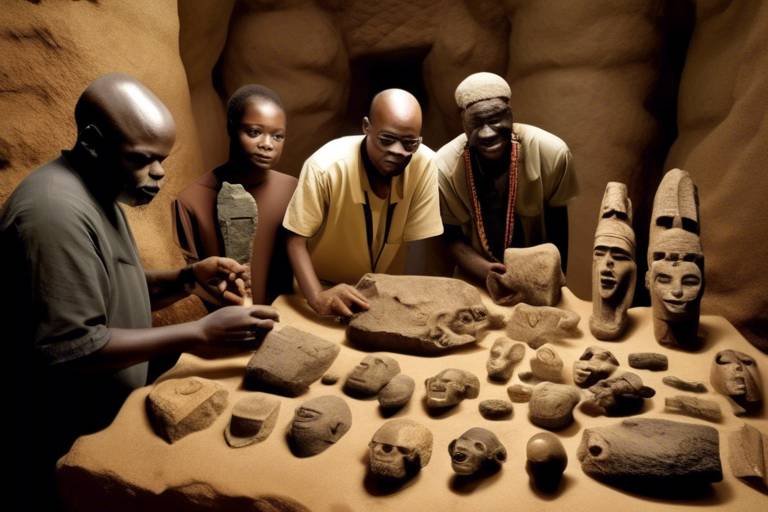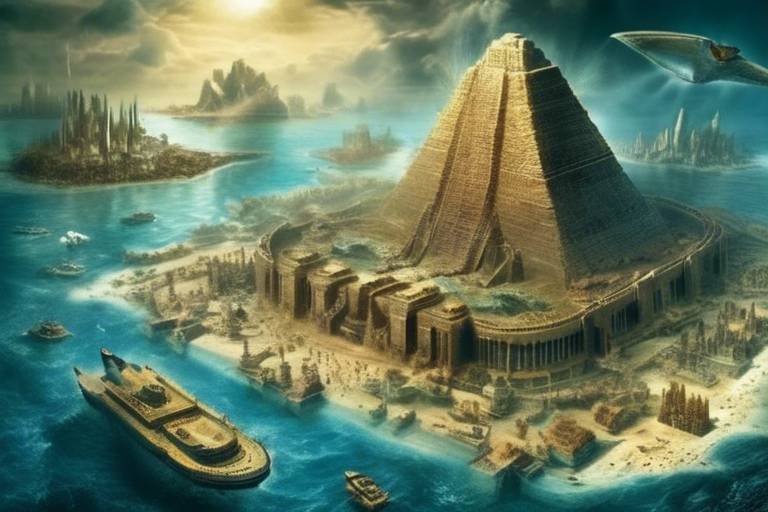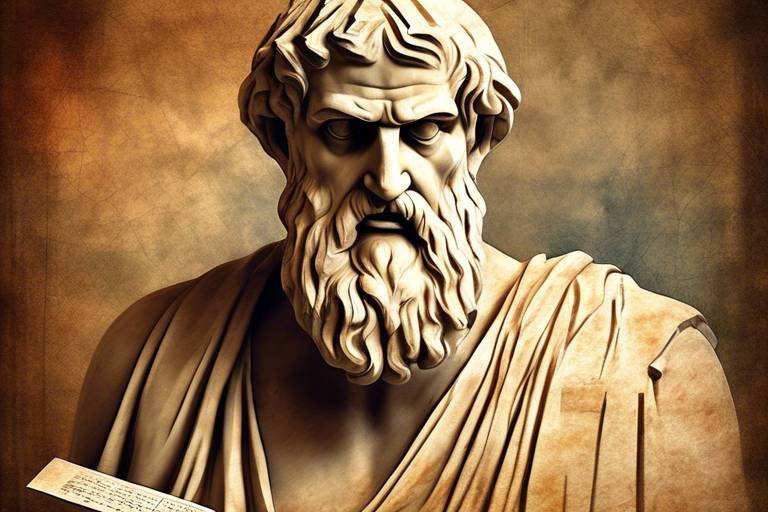The Discovery of the Ancient Egyptian Underworld
Exploring the fascinating findings and revelations about the ancient Egyptian underworld takes us on a journey through time and culture, unveiling the intricate beliefs, burial practices, and the profound significance of the afterlife in Egyptian society. The ancient Egyptians held a deep reverence for the mysteries of the underworld, shaping their rituals, art, and even governance.
Unraveling the mythical origins of the underworld leads us into a realm where deities like Osiris and Anubis play pivotal roles in guiding the deceased through the afterlife. These myths and legends not only provided comfort and assurance to the living but also laid the foundation for the elaborate funerary practices and beliefs that defined ancient Egyptian culture.
Delving into the realm of archaeological excavations, we unearth tombs, mummies, and artifacts that offer glimpses into the ancient Egyptian worldview regarding the afterlife. These discoveries not only showcase the grandeur and sophistication of their burial practices but also provide valuable insights into their spiritual beliefs and customs surrounding death.

Mythical Origins of the Underworld
Unveiling the mystical origins of the ancient Egyptian underworld takes us on a journey through the rich tapestry of myths and legends that shaped their beliefs about the afterlife. Central to these beliefs were the prominent deities such as Osiris, the god of the afterlife and resurrection, and Anubis, the god of mummification and the protector of the dead. These divine figures played crucial roles in guiding the deceased through the perilous journey to the underworld, where their ultimate fate would be determined.
The ancient Egyptians believed that the underworld, known as the Duat, was a realm of both danger and opportunity. It was a place where the souls of the deceased underwent a series of trials and judgments before reaching their final destination. The myths surrounding the underworld were intricately woven into the fabric of Egyptian society, influencing everything from burial practices to religious rituals.
One of the most enduring legends associated with the underworld is the story of Osiris, the god-king who was murdered by his jealous brother Set and later resurrected to become the ruler of the afterlife. Osiris symbolized the cycle of death and rebirth, offering hope to the deceased that they too could overcome the trials of the underworld and achieve eternal life.
Archaeological excavations have unearthed a wealth of artifacts and inscriptions that provide valuable insights into the ancient Egyptian beliefs about the underworld. From elaborate tombs filled with treasures to intricate spells and incantations inscribed on papyri, these discoveries offer a glimpse into the complex and fascinating world of the afterlife as envisioned by the ancient Egyptians.

Archaeological Excavations
Archaeological excavations have been instrumental in uncovering the mysteries of the ancient Egyptian underworld. Through painstaking efforts and meticulous research, archaeologists have unearthed tombs, mummies, and artifacts that provide valuable insights into the beliefs and practices of the ancient Egyptians regarding the afterlife. These excavations have revealed the elaborate burial rituals and ceremonies conducted by the ancient Egyptians to ensure a safe passage to the underworld and a successful journey to the afterlife.
One of the most significant discoveries in archaeological excavations related to the ancient Egyptian underworld is the tomb of Tutankhamun, also known as King Tut. This remarkable find shed light on the opulent burial practices of the pharaohs and the treasures they believed were necessary for the afterlife. The tomb of Tutankhamun contained a wealth of artifacts, including jewelry, furniture, and statues, all carefully placed to accompany the young pharaoh on his journey to the underworld.
Furthermore, excavations have revealed the existence of the Book of the Dead, a collection of spells and instructions that were buried with the deceased to assist them in navigating the challenges of the afterlife. These texts provided guidance on how to overcome obstacles and judgment in the underworld, emphasizing the importance of proper preparation for the journey beyond death.
Archaeological excavations continue to uncover new findings and expand our understanding of the ancient Egyptian beliefs surrounding the underworld. By studying the tombs, inscriptions, and artifacts left behind by this ancient civilization, archaeologists and scholars are able to piece together the intricate cosmology and spiritual practices that guided the Egyptians in their quest for eternal life.

Tombs of the Pharaohs
Exploring the fascinating findings and revelations about the ancient Egyptian underworld, shedding light on their beliefs, burial practices, and the significance of the afterlife in Egyptian culture.
Investigating the myths and legends that shaped the ancient Egyptian concept of the underworld, including the role of deities like Osiris and Anubis in guiding the deceased.
Detailing the archaeological discoveries that have unearthed tombs, mummies, and artifacts shedding light on the ancient Egyptian beliefs and practices related to the underworld.
The tombs of the pharaohs in ancient Egypt stand as magnificent testaments to their beliefs in the afterlife. These elaborate structures were meticulously designed to ensure a safe passage for the pharaoh into the next world. Decorated with intricate hieroglyphics and filled with treasures, the tombs of pharaohs like Tutankhamun and Ramses II serve as windows into the grandeur and complexity of ancient Egyptian burial practices.
Examining the significance of the Book of the Dead in ancient Egyptian funerary practices, a collection of spells and instructions to assist the deceased in the afterlife.
Discussing the ancient Egyptian beliefs in the afterlife, the judgment of the soul by Osiris, and the journey through the underworld to reach eternal paradise.
Exploring the myth of Osiris judging the deceased by weighing their heart against the feather of Ma'at, symbolizing truth and justice in the afterlife.
Analyzing how modern scholars and archaeologists interpret the ancient Egyptian underworld beliefs, drawing connections to contemporary views on death and the afterlife.
Highlighting the influence of discoveries related to the ancient Egyptian underworld on the field of Egyptology, shaping our understanding of this ancient civilization.

Book of the Dead
The holds a significant place in ancient Egyptian funerary practices, serving as a guidebook for the deceased on their journey through the afterlife. This collection of spells and instructions, also known as the Book of Coming Forth by Day, was placed in the tomb of the deceased to assist them in navigating the challenges of the underworld and reaching eternal paradise.
Written on papyrus scrolls or inscribed on tomb walls, the contained spells to help the soul overcome obstacles, avoid dangers, and pass the judgment of Osiris successfully. The text emphasized the importance of moral behavior, recitation of spells, and the knowledge of magical formulas to ensure a smooth transition to the afterlife.
One of the central themes of the was the concept of Ma'at, the ancient Egyptian goddess of truth and justice. The deceased's heart was weighed against the feather of Ma'at during the judgment process, symbolizing the balance between one's deeds in life and the principles of truth and order.
Through the guidance provided in the , the ancient Egyptians believed that the deceased could navigate the perils of the underworld, overcome challenges, and ultimately achieve eternal life in the Field of Reeds. The spells and rituals outlined in this sacred text were essential for ensuring a successful journey to the afterlife and eternal bliss.

Life After Death Beliefs
Exploring the fascinating findings and revelations about the ancient Egyptian underworld, shedding light on their beliefs, burial practices, and the significance of the afterlife in Egyptian culture.
Investigating the myths and legends that shaped the ancient Egyptian concept of the underworld, including the role of deities like Osiris and Anubis in guiding the deceased.
Detailing the archaeological discoveries that have unearthed tombs, mummies, and artifacts shedding light on the ancient Egyptian beliefs and practices related to the underworld.
Exploring the elaborate tombs of pharaohs like Tutankhamun and Ramses II, designed to ensure a safe passage to the afterlife and filled with treasures for the journey.
Examining the significance of the Book of the Dead in ancient Egyptian funerary practices, a collection of spells and instructions to assist the deceased in the afterlife.
The ancient Egyptians held strong beliefs in the afterlife, viewing death as a mere transition rather than an end. Central to their beliefs was the concept of judgment in the afterlife, where the soul of the deceased would stand trial before Osiris, the god of the underworld. This judgment involved the weighing of the heart of the deceased against the feather of Ma'at, the goddess of truth and justice. If the heart was found to be lighter than the feather, the soul would be deemed pure and granted passage to the eternal paradise known as the Field of Reeds. However, if the heart was heavy with sin, it would be devoured by the fearsome monster Ammit, condemning the soul to eternal darkness.
In Egyptian mythology, Osiris played a crucial role in the afterlife as the god of the underworld and the judge of the deceased. The myth of the weighing of the heart symbolized the importance of leading a just and righteous life, as only those who lived in accordance with Ma'at, the cosmic order, could hope for a favorable judgment in the afterlife.
Analyzing how modern scholars and archaeologists interpret the ancient Egyptian underworld beliefs, drawing connections to contemporary views on death and the afterlife.
Highlighting the influence of discoveries related to the ancient Egyptian underworld on the field of Egyptology, shaping our understanding of this ancient civilization.

Osiris and the Weighing of the Heart
In ancient Egyptian mythology, Osiris, the god of the afterlife and the underworld, played a crucial role in the judgment of the deceased. According to the belief, upon death, the soul of the deceased would undergo a journey through the underworld, where it would face a final judgment before reaching the eternal paradise. This judgment was symbolized by the weighing of the heart ceremony, a pivotal moment in the afterlife journey.
The weighing of the heart ceremony was depicted in the Book of the Dead as a scene where the heart of the deceased was weighed against the feather of Ma'at, the goddess of truth and justice. The heart, representing the essence of the individual's life and deeds, had to be as light as the feather to pass the judgment and proceed to the afterlife. If the heart was heavy with sins and wrongdoing, it would be devoured by the monstrous creature Ammit, condemning the soul to oblivion.
This symbolic ritual underscored the importance of leading a righteous and moral life according to Ma'at, the cosmic order, to ensure a favorable outcome in the afterlife. The concept of balance and harmony in one's actions and intentions was central to the belief system of ancient Egyptians, reflecting their deep reverence for justice and ethical conduct.
The myth of Osiris and the weighing of the heart not only provided a moral framework for individuals in ancient Egypt but also served as a powerful metaphor for the eternal struggle between good and evil, light and darkness. It encapsulated the fundamental principles of Egyptian religion and philosophy, emphasizing the eternal quest for spiritual purity and enlightenment.

Modern Interpretations
Modern Interpretations of the ancient Egyptian underworld beliefs offer a fascinating glimpse into how scholars and archaeologists today analyze and interpret the rich tapestry of Egyptian mythology and funerary practices. By delving into the intricate details of tombs, inscriptions, and artifacts left behind by this ancient civilization, modern experts strive to unravel the mysteries of the afterlife as perceived by the Egyptians.
One key aspect of modern interpretations revolves around the symbolic significance of the intricate burial rituals and beliefs in the afterlife. Scholars often draw parallels between ancient Egyptian concepts of death and rebirth with contemporary views on mortality and spirituality. The exploration of the underworld myths and deities such as Osiris and Anubis provides a deeper understanding of how the Egyptians viewed the transition from life to the afterlife.
Furthermore, modern interpretations shed light on the societal and cultural aspects that influenced ancient Egyptian beliefs about the underworld. By examining the role of pharaohs, priests, and common people in funerary practices, researchers can piece together a more comprehensive picture of how these beliefs were intertwined with daily life and social structures in ancient Egypt.
Through a multidisciplinary approach that combines archaeology, anthropology, and Egyptology, modern interpretations aim to bridge the gap between the past and the present, offering insights into the enduring legacy of ancient Egyptian beliefs in the afterlife. By exploring the nuances of burial customs, religious texts, and artistic representations, scholars continue to unravel the complexities of the ancient Egyptian underworld and its significance in the broader context of human history.

Impact on Egyptology
The discovery of the ancient Egyptian underworld has had a profound impact on the field of Egyptology, revolutionizing our understanding of this ancient civilization. The archaeological findings related to tombs, mummies, and artifacts have provided invaluable insights into the beliefs, rituals, and practices of the ancient Egyptians concerning the afterlife. By studying these discoveries, researchers have been able to piece together a more comprehensive picture of the religious and funerary customs of the ancient Egyptians.
One of the key contributions of the exploration of the ancient Egyptian underworld to Egyptology is the elucidation of the intricate belief system surrounding death and the afterlife. The detailed depictions found in tombs, such as the Book of the Dead, have offered scholars a glimpse into the spiritual journey that the deceased were believed to undertake after passing into the underworld. These insights have not only enhanced our knowledge of ancient Egyptian religious practices but have also prompted reevaluations of our own conceptions of life after death.
Moreover, the impact of the discoveries related to the ancient Egyptian underworld extends beyond academic circles. The public fascination with the mysteries of the afterlife in ancient Egypt has fueled interest in Egyptology, leading to increased public engagement with the field. Museums around the world have showcased artifacts and exhibits related to the ancient Egyptian underworld, captivating audiences and sparking curiosity about this ancient civilization.
Furthermore, the discoveries associated with the ancient Egyptian underworld have inspired interdisciplinary collaborations and research initiatives. Scholars from various fields, including archaeology, anthropology, and religious studies, have come together to unravel the complexities of ancient Egyptian beliefs and practices. This interdisciplinary approach has enriched our understanding of the cultural, social, and religious dynamics of ancient Egyptian society, shedding light on its enduring legacy.
Frequently Asked Questions
- What is the significance of the ancient Egyptian underworld?
The ancient Egyptian underworld held immense significance in their culture, representing the journey of the deceased to the afterlife. It was believed to be a realm where the soul would be judged before reaching eternal paradise.
- Who were the key deities associated with the ancient Egyptian underworld?
Deities like Osiris and Anubis played crucial roles in guiding the deceased through the underworld. Osiris, the god of the afterlife, was particularly important in the judgment of souls.
- What is the Book of the Dead and why was it important?
The Book of the Dead was a collection of spells and instructions meant to assist the deceased in navigating the afterlife. It was essential for ensuring a safe passage and proper judgment in the underworld.
- How did the ancient Egyptians prepare for the afterlife?
Ancient Egyptians prepared for the afterlife by constructing elaborate tombs, filling them with treasures, and ensuring they were buried with items necessary for the journey. They also believed in leading a virtuous life to pass the judgment of Osiris.
- What impact have archaeological discoveries related to the ancient Egyptian underworld had on modern understanding?
Archaeological findings related to the ancient Egyptian underworld have greatly influenced modern interpretations of Egyptian beliefs and practices. They have provided valuable insights into the culture, religion, and funerary customs of this ancient civilization.



















